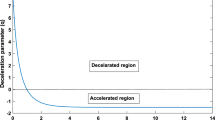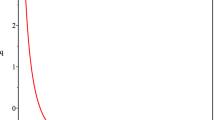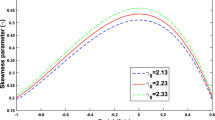Abstract
The investigation in the present work is carried out on the spatially homogeneous and anisotropic axially symmetric space-time in the presence of two fluids, one being the pressureless matter and other being the different kinds of holographic dark energy (HDE). Eventually, in the present work, cosmological models with Tsallis HDE, Renyi HDE, Sharma–Mittal HDE by taking Hubble radius as infrared (IR) cutoff (\(L=H^{-1}\)) are obtained. The geometrical and matter parts of space-time are solved within the Saez–Ballester scalar-tensor theory of gravitation. Interestingly, in this study a time varying deceleration parameter (q) which exhibits a transition from deceleration to acceleration phase is obtained without assuming any scale factor. In the present work, the study of cosmic expansion is done through the scalar field (\(\phi\)) and various cosmological parameters like EoS, deceleration, statefinder, etc. The EoS parameter exhibits quintom-like behavior for Tsallis HDE model, the transition from matter-dominated phase to phantom phase for Renyi HDE model, whereas it shows quintessence behavior for Sharma–Mittal HDE. The stability analysis for three models is studied through the squared speed of sound (\(v_s^2\)). For all redshift (z) values \(v_s^2>0\), the Sharma–Mittal HDE model is stable throughout the universe’s expansion. In this work, the obtained results match with recent observational data.




















Similar content being viewed by others
Data Availability Statement
Data sharing is not applicable to this article as no datasets were generated or analyzed during the current study.
References
A.G. Riess et al., Observational evidence from supernovae for an accelerating Universe and a cosmological constant. Astron. J. 116, 1009–1038 (1998)
S. Perlmutter et al., Measurements of \(\Omega\) and \(\Lambda\) from \(42\) high-redshift supernovae. Astrophys. J. 517, 565–586 (1999)
P. Bernardis et al., A flat Universe from high-resolution maps of the cosmic microwave background radiation. Nature 404, 955–959 (2000)
S. Perlmutter et al., New constraints on and w from an independent set of \(11\) high-redshift supernovae observed with the hubble space telescope. Astrophys. J. 598, 102–137 (2003)
S. Hanany et al., MAXIMA-1: A measurement of the cosmic microwave background anisotropy on angular scales of 10 arcminutes to 5 degrees. Astrophys. J. Lett. 545, L5–L9 (2000)
C.B. Netterfield et al., A measurement by BOOMERANG of multiple peaks in the angular power spectrum of the cosmic microwave background. Astrophys. J. 571, 604–614 (2002)
D.N. Spergel et al., First year wilkinson microwave anisotropy probe (WMAP) observations: determination of cosmological parameters. Astrophys. J. Suppl. 148, 175–194 (2003)
M. Colless et al., The 2dF galaxy redshift survey: spectra and redshift. Mon. Not. R. Astron. Soc. 328, 1039–1063 (2001)
M. Tegmark et al., Cosmological parameters from SDSS and WMAP. Phys. Rev. D 69, 103501–103526 (2004)
S. Cole et al., The 2dF galaxy redshift survey: Power-spectrum analysis of the final dataset and cosmological implications. Mon. Not. R. Astron. Soc. 362, 505–534 (2005)
V. Springel, C.S. Frenk, S.M.D. White, The large-scale structure of the universe. Nature 440, 1137–1144 (2006)
C.H. Brans, R.H. Dicke, Mach’s principle and a relativistic theory of gravitation. Phys. Rev. D 124, 925–935 (1961)
D. Saez, V.J. Ballester, A simple coupling with cosmological implications. Phys. Lett. A 113, 467–470 (1986)
A.D. Felice, S. Tsujikawa, \(f(R)\) Theories. Living Rev. Relativ. 13, 3–163 (2010)
V. Sahni, The cosmological constant problem and quintessence. Class. Quant. Grav. 19, 3435–3448 (2002)
S. Nojiri, S.D. Odintsov, Unified cosmic history in modified gravity: from \(f(R)\) theory to Lorentz non-invariant models. Phys. Rep. 505, 59–144 (2011)
E.V. Linder, Einstein’s other gravity and the acceleration of the universe. Phys. Rev. D 81, 127301–127303 (2010)
R. Ferraro, F. Fiorini, Non-trivial frames for \(f(T)\) theories of gravity and beyond. Phys. Lett. B 702, 75–80 (2011)
M. Sharif, S. Rani, Wormhole solutions in \(f(T)\) gravity with noncommutative geometry. Phys. Rev. D 88, 123501–123510 (2013)
T. Harko, S.N. Francisco, F.S.N. Lobo, S. Nojiri, S.D. Odintsov, \(f(R, T)\) gravity. Phys. Rev. D 84, 024020–024031 (2011)
S. Weinberg, The cosmological constant problem. Rev. Mod. Phys. 61, 1 (1989)
J. Martin, The phenomenological approach to modeling the dark energy. Compt. Rend. Phys. 13, 566 (2012)
M. Malekjani, T. Naderi, F. Pace, Effects of ghost dark energy perturbations on the evolution of spherical overdensities. Mon. Not. R. Astron. Soc B 453, 4148–4158 (2015)
C. Armendariz-Picon, V. Mukhanov, P.J. Steinhardt, Essentials of k-essence. Phys. Rev. D 63, 103510 (2001)
T. Chiba, Tracking k-essence. Phys. Rev. D 66, 063514 (2002)
I. Zlatev, L. Wang, P.J. Steinhardt, Quintessence, Cosmic Coincidence, and the Cosmological Constant. Phys. Rev. Lett. 1999, 82, 896 (1999)
R.R. Caldwell, M. Kamionkowski, N.N. Weinberg, Phantom energy: dark energy with \(\omega <1\) causes a cosmic doomsday. Phys. Rev. Lett. 91, 071301 (2003)
P. González-Diíaz, You need not be afraid of phantom energy. Phys. Rev. D 68, 021303 (2003)
L. Amendola, F. Finelli, C. Burigana, D. Carturan, WMAP and the generalized Chaplygin gas. J. Cosm. Astrop. Phys. 7, 005 (2003)
M.C. Bento, O. Bertolami, A.A. Sen, Generalized Chaplygin gas, accelerated expansion, and dark-energy-matter unification. Phys. Rev. D 66, 043507 (2002)
Z. Keresztes, L.A. Gergely, AYu. Kamenshchik, V. Gorini, D. Polarski, Soft singularity crossing and transformation of matter properties. Phys. Rev. D 88, 023535 (2003)
M.R. Setare, The holographic dark energy in non-flat Brans-Dicke cosmology. Phys. Lett. B 644, 99–103 (2007)
K. Kleidis, N.K. Spyrou, Polytropic dark matter flows illuminate dark energy and accelerated expansion. Astron. Astrographys. 576, A23 (2015)
K. Kleidis, N.K. Spyrou, Dark Energy: The Shadowy Reflection of Dark Matter. Entropy 18, 94 (2016)
M. Li, A Model of holographic dark energy. Phys. Lett. B 603, 1 (2004)
D. Pavon, W. Zimdahl, Holographic dark energy and cosmic coincidence. Phys. Lett. B 628, 206 (2005)
Q.G. Huang, M. Li, The holographic dark energy in a non-flat universe. J. Cosm. Astrop. Phys. 8, 013 (2004)
Q.G. Huang, Y. Gong, Supernova Constraints on a holographic dark energy model. arXiv:astro-ph/0403590 (2004)
Y. Gong, Extended holographic dark energy. Phys. Rev. D 70, 064029 (2004)
G. t Hooft, Dimensional reduction in quantum gravity. arXiv:gr-qc/9310026 (1993)
L. Susskind, The World as a Hologram. J. Math. Phys. 36, 6377–6396 (1995)
A. Cohen, D. Kaplan, A. Nelson, Effective field theory, black holes, and the cosmological constant. Phys. Rev. Lett. 82, 4971 (1999)
S.D.H. Hsu, Entropy bounds and dark energy. Phys. Lett. B 594, 13 (2004)
L. Xu, Holographic dark energy model with Hubble horizon as an IR cut-off. J. Cosm. Astrop. Phys. 9, 016 (2009)
J. Liu, Y. Gong, X. Chen, Dynamical behavior of the extended holographic dark energy with the Hubble horizon. Phys. Rev. D 81, 083536 (2010)
Y. Nomura, G.N. Remmen, Area law unification and the holographic event horizon. J. High Ener. Phys. 2018, 063 (2018)
H.M. Sadjadi, The particle versus the future event horizon in an interacting holographic dark energy model. J. Cosm. Astrop. Phys 2, 026 (2007)
Z.P. Huang, Y.L. Wu, Holographic dark energy model characterized by the conformal-age-like length. Int. J. Mod. Phys. A 27, 1250085 (2012)
Z.P. Huang, Y.L. Wu, Cosmological constraint and analysis on holographic dark energy model characterized by the conformal age-like length. Int. J. Mod. Phys. A 27, 1250130 (2012)
E.K. Li, Yu. Zhang, G.J. Ling, D. Peng-Fei, Generalized holographic Ricci dark energy and generalized second law of thermodynamics in Bianchi Type I universe. Gen. Rel. Grav. 47, 136 (2015)
A. Khodam-Mohammadi, A. Pasqua, M. Malekjani, I. Khomenko, M. Monshizadeh, Statefinder diagnostic of logarithmic entropy corrected holographic dark energy with Granda-Oliveros IR cut-off. Astrophys. Spa. Sci. 345, 415 (2013)
Y. Sobhanbabu, M.Vijaya Santhi, Kantowski-Sachs Tsallis holographic dark energy model with sign-changeable interaction. Eur. Phys. J. C 81, 1040 (2021)
M.Vijaya Santhi, Y. Sobhanbabu, Bianchi type-III Tsallis holographic dark energy model in Saez-Ballester theory of gravitation. Eur. Phys. J. C 80, 1198 (2020)
S. Abe, General pseudoadditivity of composable entropy prescribed by the existence of equilibrium. Phys. Rev. E 63, 061105 (2001)
H. Touchette, When is a quantity additive and when is it extensive. Physica A 305, 84–88 (2002)
A. Majhi, Non-extensive statistical mechanics and black hole entropy from quantum geometry. Phys. Lett. B 775, 32–36 (2017)
C. Tsallis, L.J.L. Cirto, Black hole thermodynamical entropy. Eur. Phys. J. C 73, 2487 (2013)
M. Tavayef, A. Sheykhi, K. Bamba, H. Moradpour, Tsallis holographic dark energy. Phys. Lett. B. 781, 195–200 (2018)
H. Moradpour, S.A. Moosavi, I.P. Morais, I.P. Lobo, I.G. Salako, A. Jawad, Thermodynamic approach to holographic dark energy and the Renyi entropy. Eur. Phys. J. C 78, 829 (2018)
A.S. Jahromi, S.A. Moosavi, H. Moradpour, I.P. Morais, I.P. Lobo, I.G. Salako, A. Jawad, Generalized entropy formalism and a new holographic dark energy model. Phys. Lett. B 780, 21–24 (2018)
Y. Aditya, S. Mandal, P.K. Sahoo, Observational constraint on interacting Tsallis holographic dark energy in logarithmic Brans-Dicke theory. Eur. Phys. J. C 79, 1020 (2019)
U.Y. Divya Prasanthi, Y. Aditya, Anisotropic Renyi holographic dark energy models in general relativity. Results Phys. 17, 103101 (2020)
U.Y. Divya Prasanthi, Y. Aditya, Observational constraints on Renyi holographic dark energy in Kantowski-Sachs universe. Phys. Dark Univ. 31, 100782 (2021)
M. Younas, A. Jawad, S. Qummer, H. Moradpour, S. Rani, Cosmological implications of the generalized entropy based holographic dark energy models in dynamical chern-simons modified gravity. Adv. High Energy Phys. 1287932 (2019)
S. Maity, U. Debnath, Tsallis, Renyi and Sharma-Mittal holographic and new agegraphic dark energy models in D-dimensional fractal universe. Eur. Phys. J. Plus 134, 514 (2019)
A. Iqbal, A. Jawad, Tsallis, Renyi and Sharma-Mittal holographic dark energy models in DGP brane-world. Phys. Dark Univ. 26, 100349 (2019)
A. Jawad, K. Bamba, M. Younas, S. Qummer, S. Rani, Tsallis, Rényi and Sharma-Mittal holographic dark energy models in loop quantum cosmology. Symmetry 10, 635 (2018)
C.L. Bennett et al., First-year wilkinson microwave anisotropy probe (WMAP) observations: preliminary maps and basic results. Astron. Astrophys. Suppl. Ser. 148, 1–27 (2003)
O. Akarsu, C.B. Kilinc, de Sitter expansion with anisotropic fluid in Bianchi type-I space-time. Astrophys. Space Sci. 326, 315–322 (2010)
G. Ramesh, S. Umadevi, LRS bianchi type-II minimally interacting holographic dark energy model in Sáez-Ballester theory of gravitation. Astrophys. Space Sci. 361, 50 (2016)
V.U.M. Rao, U.Y.D. Prasanthi, Y. Aditya, Plane symmetric modified holographic Ricci dark energy model in Sáez Ballester theory of gravitation. Results Phys. 10, 469–475 (2018)
S.M.M. Rasouli, P.V. Moniz, Modified Sáez-Ballester scalar-tensor theory from 5D space-time. Class. Quantum Gravity 35, (1-23) (2018)
U.K. Sharma, R. Zia, A. Pradhan, Transit cosmological models with perfect fluid and heat flow in Sáez-Ballester theory of gravitation. J. Astrophys. Astron. 40, 2 (2019)
C. Chawla, R.K. Mishra, A. Pradhan, A new class of accelerating cosmological models with variable \(G\) and \(\Lambda\) in sáez and ballester theory of gravitation. Rom. J. Phys. 59, 12–25 (2014)
R.K. Mishra, H. Dua, Bulk viscous string cosmological models in Sáez-Ballester theory of gravity. Astrophys. Space Sci. 364, 195 (2019)
R.K. Mishra, A. Chand, Cosmological models in Sáez-Ballester theory with bilinear varying deceleration parameter. Astrophys Space Sci. 365, 76 (2020)
S.M.M. Rasouli et al., Late time cosmic acceleration in modified Saez-Ballester theory. Phys. Dark Univ. 27, 100446 (2020)
V.U.M. Rao, T. Vinutha, M. Vijaya Shanthi, An exact Bianchi type-V cosmological model in Saez-Ballester theory of gravitation. Astrophys. Space Sci. 312, 189-191 (2007)
C.P. Singh, M. Zeyauddin, S. Ram, Anisotropic Bianchi-\(V\) cosmological models in Saez Ballester theory of gravitation. Int. J. Modern Phys. A 28, 2719–2731 (2008)
V.U.M. Rao, M. Vijaya Santhi, T. Vinutha, Exact Bianchi type II, VIII and IX string cosmological models in Saez-Ballester theory of gravitation. Astrophys. Space Sci. 314, 73-77 (2008)
G.C. Samata, S.K. Biswal, P.K. Sahoo, Five Dimensional Bulk Viscous String Cosmological Models in Saez and Ballester Theory of Gravitation. Int. J. Theor. Phys. 52, 1 (2013)
T. Vinutha, V.U.M. Rao, G. Bekele, M. Mengesha, Dark energy cosmological models with cosmic string. Astrophys. Space Sci. 363, 188 (2018)
T. Vinutha, V.U.M. Rao, G. Bekele, K.S. Kavya, Viscous string anisotropic cosmological model in scalar-tensor theory. Indian journal of Phys. 95, 1933 (2021)
M.R. Setare, The holographic dark energy in non-flat Brans-Dicke cosmology. Phys. Lett. B 644, 99–103 (2007)
Narayan Banerjee, Diego Pavon, Holographic dark energy in Brans-Dicke theory. Phys. Lett. B 647, 477–481 (2007)
C.P. Singh, P. Kumar, Holographic Dark Energy in Brans-Dicke Theory with Logarithmic Form of Scalar Field. Int. J. Theor. Phys. 56, 3297–3310 (2017)
Dao-Jun. Liu, Hua Wang, Bin Yang, Modified holographic dark energy in DGP brane world. Phys. Lett. B 694, 6–9 (2010)
M.R. Setare, E.C. Vanegas, The cosmological dynamics of interacting holographic dark energy model. Int. J. Mod. Phys. D 18, 147 (2009)
Y. Aditya, D.R.K. Reddy, FRW type Kaluza-Klein modified holographic Ricci dark energy models in Brans-Dicke theory of gravitation. Eur. Phys. J. C 78, 619 (2019)
S. Bhattacharaya, T.M. Karade, Uniform anisotropic cosmological model with string source. Astrophys. Space Sci. 202, 69–75 (1993)
S.W. Hawking, G.F.R. Ellis, The large scale structure of Space-time, p. 88. Cambridge University Press(1975)
K.S. Thorne, Primordial element formation, primordial magnetic fields, and the isotropy of the universe. Astrophys. J. 148, 51 (1967)
J. Kristian, R.K. Sachs, Observations in cosmology. Astrophys. J. 143, 379 (1966)
R. Kantowski, R.K. Sachs, Some spatially homogeneous anisotropic relativistic cosmological models. J. Math. Phys. 7, 433 (1966)
C.B. Collins, E.N. Glass, D.A. Wilkinson, Exact spatially homogeneous cosmologies. Gen. Relativ. Gravit. 12, 805–823 (1983)
Y. Aditya, D.R.K. Reddy, Anisotropic new holographic dark energy model in Saez-Ballester theory of gravitation. Astrophys. Space Sci. 363, 207 (2018)
B. Mishra, P.K. Sahoo, Bianchi type VI h perfect fluid cosmological model in \(f(R, T)\) theory. Astrophys. Space Sci. 352, 331–336 (2014)
O. Akarsu, C.B. Kilinc, LRS Bianchi type I models with anisotropic dark energy and constant deceleration parameter. Gen. Relativ. Gravit. 42, 119–140 (2010)
K.S. Adhav, LRS Bianchi type-I universe with anisotropic dark energy in lyra geometry. Int. J. Astron. Astrophys. 1, 204 (2011)
M. Vijaya Santhi, Y. Aditya, V.U.M. Rao, Some Bianchi type generalized ghost piligrim dark energy models in general relativity. Astrophys. Space Sci. 361, 142 (2016)
M. Vijaya Santhi, V.U.M. Rao, Y. Aditya, Bianchi type-VI0 modified holographic Ricci dark energy model in a scalar-tensor theory. Can. J. Phys. 95, 179-183 (2017)
B.D. Sharma, D.P. Mittal, New non-additive measures of entropy for discrete probability distributions. J. Math. Sci. 10, 28 (1975)
N.G. Busca et al., Baryon acoustic oscillations in the Ly\(\alpha\) forest of BOSS quasars. Astron. Astrophys. 552, A96 (2013)
S. Capozziello, O. Farooq, O. Luongo, B. Ratra, Cosmographic bounds on the cosmological deceleration-acceleration transition redshift in \(f(R)\) gravity. Phys. Rev. D 90, 044016 (2014)
Y. Yang, Y. Gong, The evidence of cosmic acceleration and observational constraints. arXiv:1912.07375
J. Lu, L. Xu, M. Liu, Constraints on kinematic models from the latest observational data. Phys. Lett. B 699, 246–250 (2011)
V. Sahni, T.D. Saini, A.A. Starobinsky, U. Alam, Statefinder-a new geometrical diagnostic of dark energy. J. Exp. T. Phys. Lett. 77, 201–206 (2003)
U. Alam, V. Sahni, T.D. Saini, A.A. Starobinsky, Exploring the expanding Universe and dark energy using the statefinder diagnostic. Mon. Not. R. Astron. Soc. 344, 1057–1074 (2003)
C.M. Chen, W.F. Kao, Stability analysis of anisotropic inflationary cosmology. Phys. Rev. D 64, 124019 (2001)
M. Sharif, M. Zubair, Energy conditions constraints and stability of power law solutions in \(f(R, T)\) gravity. J. Phys. Soc. Jpn. 82, 014002 (2013)
P. Sahoo, S. Bhattacharjee, S.K. Tripathy, P.K. Sahoo, Bouncing scenario in \(f(R, T)\) gravity. Phys. Lett. A 35, 2050095 (2020)
B. Saha, H. Amirhashchi, P. Anirudhan, Two-fluid scenario for dark energy models in an FRW universe-revisited. Astrophys. Space Sci. 342, 257–267 (2012)
L.K. Sharma, A.K. Yadav, P.K. Sahoo, B.K. Singh, Non-minimal matter-geometry coupling in Bianchi I space-time. Results Phys. 10, 738 (2018)
P.A.R. Ade et al., Planck 2015 results: \(XIII\) cosmological parameters. Astron. Astrophys. 594, A13 (2016)
M. Tegmark et al., The three-dimensional power spectrum of galaxies from the Sloan digital sky survey. Astrophys. J. 606, 702 (2004)
N. Aghanim, et al., Plancks Collaboration,Planck 2018 results. \(VI\). Cosmological parameters. arXiv:1807.06209v2 (2018)
Acknowledgements
The authors are thankful to Dr. K. Sri Kavya, MVGR College of Engineering, Vizianagaram for her valuable suggestions rendered during this work. Also, the author Vinutha Tummala would like to thank the authorities of the Inter-University Centre for Astronomy and Astrophysics, Pune, India, for providing the research facilities. The authors are much delighted to thank the honorable editor and anonymous reviewer for their valuable suggestions and useful comments which helped us a lot to improve this paper in terms of quality as well as presentation.
Author information
Authors and Affiliations
Corresponding author
Ethics declarations
Conflict of interest
The authors declare that they have no competing interests.
Appendix
Appendix
By using Eqs. (32), (37), (42), (45), (46), (47) and its derivatives in (50), we obtain the expressions for \(v_s^2\). The following equations (62), (63), (64) represent \(v_s^2\) for Tsallis, Renyi, Sharma–Mittal HDE models, respectively. These are as follows
where
Rights and permissions
Springer Nature or its licensor (e.g. a society or other partner) holds exclusive rights to this article under a publishing agreement with the author(s) or other rightsholder(s); author self-archiving of the accepted manuscript version of this article is solely governed by the terms of such publishing agreement and applicable law.
About this article
Cite this article
Vinutha, T., Vasavi, K.V. The study of accelerating DE models in Saez–Ballester theory of gravitation. Eur. Phys. J. Plus 137, 1294 (2022). https://doi.org/10.1140/epjp/s13360-022-03477-x
Received:
Accepted:
Published:
DOI: https://doi.org/10.1140/epjp/s13360-022-03477-x




